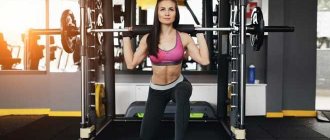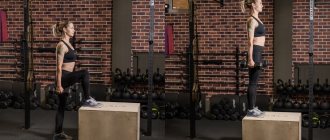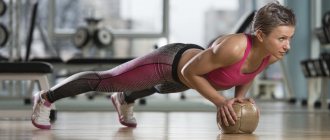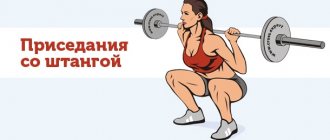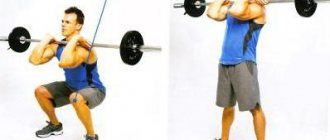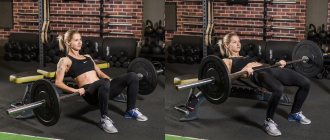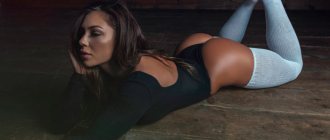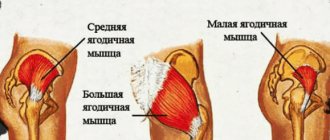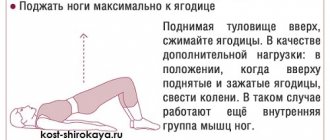There is a stereotype in fitness that only girls need to train their buttocks. However, it is no less important for men to work this muscle area. Weak buttocks can become a limiting factor in many exercises; moreover, their functions will be transferred to the lower back, increasing the risk of hernias and protrusions. Exercises for the buttocks with dumbbells are best for working out the muscle mass. They are more versatile, suitable for people with any level of physical fitness, and the whole range of movements can be performed even at home.
What areas will we use?
This article will describe squats with dumbbells for girls for the buttocks and thighs. We will use:
- Adductor muscle (we wrote about it above).
- The back surface of the biceps femoris.
- Buttocks.
- The front of the thigh.
Some techniques are designed for complex pumping of the hips and buttocks, but there are “problem areas” that require special exercises. For example, the adductor muscle of the thigh (inner thigh).
The skin in this area is much thinner - this makes it less elastic. This is where fat accumulates. Thin skin and a dense layer of fat make the area flabby and aesthetically unattractive. We will discuss exercises for this and other problem areas separately.
Note! Some exercises additionally work your back. It won't make you more attractive, but it will make you healthier if done in moderation. The work also slightly involves the calf muscles and shoulders. We still focus on the butt and hips.
Recommendations for choosing exercises for weight loss
It has long been known that regular physical activity only in combination with a proper diet leads to excess weight loss. For many women, this aspect is the most relevant, and it is this aspect that is often given with great difficulty, because while you can still find time for training, eating wisely is much more difficult.
Read more: How to take peptides and instructions for diluting them
Before we talk about exactly which exercises with dumbbells for women and girls will help you get a flawless figure, carefully read a few important recommendations. They will make the process of training and losing weight faster and more effective:
- A flat stomach and thin waist are 100% the result of following a proper diet. The stereotype that you can locally burn fatty tissue in the abdominal area through ultra-intensive training on the abs and oblique muscles has long since faded away. However, this does not mean that girls do not need core training. Perform sit-ups with dumbbells in your hands, crunches with additional weights and vacuum to tone your abdominal muscles and prevent sagging skin as a result of rapid weight loss.
- The same applies to deposits on the buttocks and thighs. Exercising these areas won't burn fat on its own, but it will help tone your muscles and increase your overall calorie burn. In combination with diet, this will ultimately lead to excellent results.
- The general conclusion is that the set of exercises for gaining muscle mass and losing weight can be the same. The whole difference will be in nutrition. In the first case, you need a daily calorie surplus, in the second, a deficit of 10-20% of your norm. So you can safely choose any exercises you like from the list that will be presented below.
- A good option for exercising with dumbbells for weight loss is circuit training. We perform one exercise for each muscle group (do it from top to bottom: shoulders, back, chest, arms, quadriceps, hamstrings, buttocks). We do 3-5 laps in total (beginners should start with 2). We change exercises with each circle, without resting between them. Let's rest for 2-3 minutes between circles. Calorie losses with circuit training are higher than with regular training, which can be useful for you during your weight loss period.
The benefits and harms of squats with dumbbells
If you're not yet sure whether to add squats to your workout, consider their benefits:
- Effectively help with excess weight. Using the techniques described, we say goodbye to fat by increasing muscle mass. Squats will help you quickly form an attractive figure, even if you are overweight.
- They have pleasant side effects. It’s not for nothing that squats are included in the warm-up of track and field athletes. They will significantly increase your overall flexibility and speed.
- Helps cope with back pain. As we mentioned above, some exercises involve the back muscles. This improves posture and helps cope with pain when walking for a long time (the main thing is not to get carried away).
- Improve blood circulation. Thanks to better functioning of blood vessels in the pelvic area, you can normalize metabolism, tighten the skin and improve its general condition.
- Reduce the risk of injury. It is very difficult to stretch or damage reinforced tissue. The muscles become not only strong, but also flexible.
- Very comfortably. You can exercise at home or in the gym.
With the correct technique, suitable weighting material and the absence of contraindications, squats cannot harm your body.
Note! Unsuitable (too heavy) dumbbells can lead to knee problems. Track and field athletes, football players and bodybuilders often encounter such troubles. The latter is helped to relieve the load by special protection - chondroprotectors. You won't need them unless you want to build a lot of muscle mass.
Problems can also start if you make mistakes in the exercises. We will talk about them later.
When should you not squat?
Before starting squats, we recommend that you consult a physical therapist. If not, at least read all the contraindications.
Squats with dumbbells should not be performed if you have problems with the spine, scoliosis, varicose veins, hernia, sciatica or hypertension. Women with cardiovascular disease and joint pain should also not exercise.
We warn young mothers: you can do squats no earlier than 6-7 weeks after pregnancy.
Variations of the exercise
So, what types of dumbbell squats are there?
- Plie or sumo - with wide legs and toes turned outward. In a squat, the knees move apart. The projectile is held in lowered hands in front of you;
- Bulgarian lunges - one leg is pulled back and placed on a gymnastic bench with the toe down. Dumbbells are held in lowered hands;
- Squats with dumbbells on the shoulders are an analogue of squats with a barbell;
- Deep squats with dumbbells in front of you in your hands are a popular exercise in which, most often, the apparatus is held in front of the chest;
- Single leg squats with dumbbells or pistol squats. Requires a developed sense of balance and strong knees. The projectiles are held in the hands, similar to the Bulgarian lunges. By the way, weight helps control balance;
- Squats with dumbbells over the top of the head;
- Lunges – straight or scissor. Dumbbells should be held in lowered hands;
Read more: Vertical pull-down and all the features of performing the exercise
When will the result be noticeable?
Immediately focus on working on yourself. You will feel fit within a week, but you will be able to get a really impressive butt no earlier than after 6 months. If you are reading this in winter, start today, everything will work out by summer.
To speed up the process, follow these guidelines:
- Follow a diet - give up baking and sweets. Eat meat, eggs, fish, cheese products. Try to eat a balanced diet. Without protein, muscles will not grow.
- You don't need to exercise every day. Three times a week will be enough. Exercise for 40 minutes until you feel tired. After training, do a short massage to disperse lactic acid.
- Choose a weight that is comfortable for you and periodically (the main thing is gradually) increase it.
If you do everything correctly, after 3 months a good relief will begin to emerge, the buttocks will become more voluminous and elastic.
Dumbbell squat technique
We will show you 3 exercises that comprehensively involve the muscle groups we have already mentioned. This will be enough for you to achieve the desired results.
Classic squat
The classic squat is known to every person who has ever been to the gym. This is one of the first exercises that the trainer shows - the main load is aimed at the quadriceps.
It can be done with a barbell, kettlebells or other weights. There is no big difference in effectiveness, but it is safest to do this with dumbbells.
Step 1 – take dumbbells and stand with your feet shoulder-width apart (a little wider if possible). Your palms should be facing the floor and your eyes should be straight ahead.
Step 2 – As you inhale, begin to lower yourself down, bending your knees. Make sure that your heels are “glued” to the floor and that your knees do not go too far beyond the level of your toes.
Step 3 - Stop when your thighs are parallel to the floor. Push your heels off the floor and begin to rise up to the starting position. Exhale with effort.
Repeat the squat 12-15 times for 2-3 approaches. Rest between sets.
Note! This exercise can also be performed with bent elbows or one dumbbell. If you train with one dumbbell, grab it by the weight plate with both hands.
Plie squat
The term “plie” came to gyms straight from ballet. It literally means “to bend the leg.” The feet are in the first position - as far apart as possible. This is exactly the exercise we talked about above. It will help remove fat from the inner thigh and tighten it.
Step 1 - Hold one dumbbell with both hands, place your feet wider than shoulder-width apart, and turn your toes out so that you can draw a straight line along your feet. If you feel that your hips are not tense enough, turn your toes even further to the sides. Move your pelvis back a little, straighten your back in a natural arch.
Step 2 – Start squatting as you exhale, holding the dumbbell down. Your knees should point in the same direction as your feet. Squat to your maximum. Ideally, your thighs should be parallel to the floor, as in a classic squat.
Step 3 – Having reached the maximum point, hold for 1-2 seconds. As you exhale, slowly rise up. Do not return completely to the starting position - the exercise will be more effective if your legs are tense all the time.
Perform 10-15 of these squats per set. 3-4 approaches per workout will be enough.
Note! The plie squat requires a good stretch. You won’t be able to sit low enough right away. To increase the effectiveness of the exercise, do a special warm-up before training. We'll talk about it below.
Sumo squat
The sumo squat is very similar to the plie. They work the inner thighs, quadriceps and glutes. Classic squats put stress on the back muscles. Sumo doesn't use them.
Step 1 – Grasp one dumbbell with both hands by the disc and stand with your feet wider than shoulder-width apart. Turn your toes approximately 45 degrees.
Step 2 – Inhale and lean back slightly. Start squatting so that your toes and knees do not move inward. Pull your pelvis back to the maximum. At the extreme point, the thighs should be parallel to the floor.
Step 3 – As you exhale, return to the starting position.
This is a moderate intensity exercise. Perform it 10-15 times, do 3-4 approaches.
Note! When you squat below parallel to the floor, the gluteus maximus receives more load. But in this case, the load on the knee joint increases significantly. It's better not to do that.
Mistakes when performing squats
To pump up your buttocks and avoid unnecessary injury during training sessions, you need to avoid common mistakes:
- A serious mistake is transferring the center of gravity to the foot (front part). The consequences of this mistake are loss of balance. The girl will certainly fall forward. Shifting your body weight to your heels or the outside of your feet can help save the situation.
- When performing a squat, you cannot turn your knees either towards the center or outwards. Keep an eye on your knees at all times; during a squat, they should never protrude beyond your toes.
- During squats, you should not slouch; your back should be absolutely straight.
- In the starting position, you cannot spread your toes at an angle greater than 30°.
- When doing a squat, tighten your back muscles while maintaining your spine.
- Looking straight makes it easier to keep your back in the correct position.
If you avoid common mistakes during squats, there will be no harm to your health.
A few more tips
While you have not yet started training, pay attention to a few nuances that will help increase your productivity.
Warm-up
How do muscles grow? Under the weight, they receive microtraumas, and are later restored by the body. They are restored with the expectation that the load may be repeated again. Thus, the fabric becomes more flexible, stronger and more voluminous. Without heating, the fibers are destroyed prematurely, without waiting for a surge of growth hormone.
By neglecting to warm up, you also increase the load on your joints and may end up with a sprain.
To ease into squats, take a few minutes to:
- Stretching the internal and posterior thigh muscles.
- Bends and twists of the body.
- Warming up the knees and Achilles tendon.
If possible, run at a slow pace for 500 meters on a treadmill. After warming up, your heart rate should rise to 100 beats per minute - this means that your body is ready for training.
What weight should I take?
If you have just started pumping your hips and buttocks, try doing a few workouts without weights. You need to learn technique and balance. If you are confident in your abilities, take dumbbells:
- 2 kg. Suitable for weight loss. They need to be practiced at a faster pace. Preferably with rhythmic music.
- From 2 to 12 kg. Suitable for building and strengthening muscles. Increase the weight if life doesn't seem so bad during your workout.
Note! Choose a weight that you are comfortable with. It is better to reduce the load if you feel that you cannot complete the given set of approaches.
Analysis of the exercise
The main movers in the exercise are the entire array of gluteal muscles, quadriceps, and hamstrings. The hamstrings and buttocks are prioritized. The longus dorsi muscle also works; it is impossible to say that the back does not work here.
The latissimus and abdominal muscles work as stabilizers. During the grip, the hands and forearm muscles are used.
Beginners can start with an anatomically comfortable foot placement. There is no need to immediately “get into the splits” and try to sit down in this position. This usually ends with inflammation of the hip joint and discomfort in the lumbar region.
Stretching is important, but you won’t be able to “pull” yourself into the correct starting position. Therefore, it is recommended to simply do the exercise and perform “pre-stretching” in a dynamic manner.
Usually this movement comes first or second in a beginner’s plan, so first perform mfr, cardio warm-up, joint warm-up, and a couple of approaches without weights or with minimal weight.
The most common mistakes
Exercises are of no use if you do them incorrectly. Some mistakes in training can only harm your figure, not improve it. Most often when doing squats, beginners:
- Lift your heels off the floor! You can't do that. If you can’t do a deep squat without lifting your heels, then you have problems with stretching your calf muscles. Sit on the floor, stretch your legs forward, grab your toes and reach forward towards your toes without bending your knees. This will help.
- The knees go inwards! Make sure your knees point in the same direction as your toes. If you can’t follow this, pull a rubber expander band above your knees. You will feel a change in tension and automatically bring your knees into the correct position.
- Squat not deep enough! Without a deep squat, the glutes are not engaged. Usually the problem is that the hip joint is not flexible enough. Perform hamstring stretches.
The back is rounded! To easily learn not to round your back, do the exercise near a wall. Touch it with your hands directly in front of you and do a squat without lifting your hands. Try it, you will succeed.
Recommendations
The farther the working leg is from the hill (bench), the more the hamstrings will be involved. Accordingly, the closer the leg is located, the greater the load on the quadriceps. If the foot is placed straight, the load will be aimed at the quadriceps, and if the foot is turned 45 degrees to the side, the emphasis will shift to the adductors.
- There is no need to use heavy weights for beginners.
- The main thing is to monitor the execution technique. Do not bend over or fall over. Keep your back straight.
- Be sure to do warm-up approaches and prepare the ligaments and joints for stress without weights.
Bulgarian lunges are best performed after heavy basic exercises as an additional load. Here's an example of a workout using Bulgarian lunges:
- Squats with a barbell.
- Bulgarian lunges.
- Romanian cravings.
- Leg extension in the simulator.
- Shin exercises.
- 1. Barbell Squat
- 2. Bulgarian lunges
- 3. Romanian deadlift
- 4. Leg extension in the simulator
- 5. Shin exercises
Bulgarian lunges can be included in the training process for both women and men.
- For men, the optimal training regimen consists of 3-4 sets of 8-12 repetitions each;
- for women, 3 sets of 15-20 repetitions will be enough.
For women, such lunges can be included in circuit training, and can also be used in a superset, for example, step-ups with weights on a bench and Bulgarian lunges, or another option - Bulgarian lunges and leg curls in the machine.
